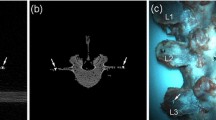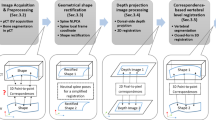Abstract
Purpose
Although multiple algorithms have been reported that focus on improving the accuracy of 2D–3D registration techniques, there has been relatively little attention paid to quantifying their capture range. In this paper, we analyze the capture range for a number of variant formulations of the 2D–3D registration problem in the context of pedicle screw insertion surgery.
Methods
We tested twelve 2D–3D registration techniques for capture range under different clinically realistic conditions. A registration was considered as successful if its error was less than 2 mm and 2° in 95% of the cases. We assessed the sensitivity of capture range to a variety of clinically realistic parameters including: X-ray contrast, number and configuration of X-rays, presence or absence of implants in the image, inter-subject variability, intervertebral motion and single-level vs multi-level registration.
Results
Gradient correlation + Powell optimizer had the widest capture range and the least sensitivity to X-ray contrast. The combination of 4 AP + lateral X-rays had the widest capture range (725 mm2). The presence of implant projections significantly reduced the registration capture range (up to 84%). Different spine shapes resulted in minor variations in registration capture range (SD 78 mm2). Intervertebral angulations of less than 1.5° had modest effects on the capture range.
Conclusions
This paper assessed capture range of a number of variants of intensity-based 2D–3D registration algorithms in clinically realistic situations (for the use in pedicle screw insertion surgery). We conclude that a registration approach based on the gradient correlation similarity and the Powell’s optimization algorithm, using a minimum of two C-arm images, is likely sufficiently robust for the proposed application.












Similar content being viewed by others
References
Markelj P, Tomaževič D, Likar B, Pernuš F (2012) A review of 3D/2D registration methods for image-guided interventions. Med Image Anal 16:642–661
van der Bom IMJ, Klein S, Staring M, Homan R, Bartels LW, Pluim JPW (2011) Evaluation of optimization methods for intensity-based 2D–3D registration in X-ray guided interventions. In: Dawant BM, Haynor DR (eds) SPIE medical imaging. SPIE Press, Lake Buena Vista, pp 796223-1–796223-15
Goitein M, Abrams M, Rowell D, Pollari H, Wiles J (1983) Multi-dimensional treatment planning: II. Beam’s eye-view, back projection, and projection through CT sections. Int J Radiat Oncol Biol Phys 9:789–797
De Silva T, Uneri A, Ketcha MD, Reaungamornrat S, Kleinszig G, Vogt S, Aygun N, Lo SF, Wolinsky JP, Siewerdsen JH (2016) 3D–2D image registration for target localization in spine surgery: investigation of similarity metrics providing robustness to content mismatch. Phys Med Biol 61:3009–3025
Otake Y, Schafer S, Stayman JW, Zbijewski W, Kleinszig G, Graumann R, Khanna AJM, Siewerdsen JH (2012) Automatic localization of vertebral levels in X-ray fluoroscopy using 3D-2D registration: a tool to reduce wrong-site surgery. Phys Med Biol 57:5485–5508
de Bruin PW, Kaptein BL, Stoel BC, Reiber JH, Rozing PM, Valstar ER (2008) Image-based RSA: Roentgen stereophotogrammetric analysis based on 2D–3D image registration. J Biomech 41:155–164
Aouadi S, Sarry L (2008) Accurate and precise 2D–3D registration based on X-ray intensity. Comput Vis Image Underst 110:134–151
Chen X, Varley MR, Shark L-K, Shentall GS, Kirby MC (2008) A computationally efficient method for automatic registration of orthogonal X-ray images with volumetric CT data. Phys Med Biol 53:967
Knaan D, Joskowicz L (2003) Effective intensity-based 2D/3D rigid registration between fluoroscopic X-ray and CT. In: Ellis RE, Peters TM (eds) Medical image computing and computer-assisted intervention—MICCAI 2003. Springer, Berlin, pp 351–358
Dey J, Napel S (2006) Targeted 2D/3D registration using ray normalization and a hybrid optimizer. Med Phys 33:4730–4738
Varnavas A, Carrell T, Penney G (2015) Fully automated 2D–3D registration and verification. Med Image Anal 26:108–119
Miao S (2016) Effective image registration for motion estimation in medical imaging environments. PhD thesis, University of British Columbia
Miao S, Wang ZJ, Liao R (2016) A CNN regression approach for real-time 2D/3D registration. IEEE Trans Med Imaging 35:1352–1363
Katonis P, Christoforakis J, Aligizakis AC, Papadopoulos C, Sapkas G, Hadjipavlou A (2003) Complications and problems related to pedicle screw fixation of the spine. Clin Orthop Relat Res 411:86–94
Nevzati E, Marbacher S, Soleman J, Perrig WN, Diepers M, Khamis A, Fandino J (2014) Accuracy of pedicle screw placement in the thoracic and lumbosacral spine using a conventional intraoperative fluoroscopy-guided technique: a national neurosurgical education and training center analysis of 1236 consecutive screws. World Neurosurgery 82:866–871.e2
Gautschi OP, Schatlo B, Schaller K, Tessitore E (2011) Clinically relevant complications related to pedicle screw placement in thoracolumbar surgery and their management: a literature review of 35,630 pedicle screws. Neurosurg Focus 31:E8
Gelalis ID, Paschos NK, Pakos EE, Politis AN, Arnaoutoglou CM, Karageorgos AC, Ploumis A, Xenakis TA (2011) Accuracy of pedicle screw placement: a systematic review of prospective in vivo studies comparing free hand, fluoroscopy guidance and navigation techniques. Eur Spine J 21:247–255
Choma TJ, Denis F, Lonstein JE, Perra JH, Schwender JD, Garvey TA, Mullin WJ (2006) Stepwise methodology for plain radiographic assessment of pedicle screw placement: a comparison with computed tomography. J Spinal Disord Tech 19:547–553
Cordemans V, Kaminski L, Banse X, Francq BG, Cartiaux O (2017) Accuracy of a new intraoperative cone beam CT imaging technique (Artis zeego II) compared to postoperative CT scan for assessment of pedicle screws placement and breaches detection. Eur Spine J 26:2906–2916
Santos ERG, Ledonio CG, Castro CA, Truong WH, Sembrano JN (2012) The accuracy of intraoperative O-arm images for the assessment of pedicle screw position. Spine 37:E119–E125
Learch TJ, Massie JB, Pathria MN, Ahlgren BA, Garfin SR (2004) Assessment of pedicle screw placement utilizing conventional radiography and computed tomography: a proposed systematic approach to improve accuracy of interpretation. Spine 29:767–773
Newell R, Esfandiari H, Anglin C, Bernard R, Street J, Hodgson AJ (2018) An intraoperative fluoroscopic method to accurately measure the post-implantation position of pedicle screws. Int J CARS 13:1257–1267
Esfandiari H, Newell R, Anglin C, Street J, Hodgson AJ (2018) A deep learning framework for segmentation and pose estimation of pedicle screw implants based on C-arm fluoroscopy. Int J CARS 13:1269–1282
Penney GP, Weese J, Little JA, Desmedt P, Hill DLG, Hawkes DJ (1998) A comparison of similarity measures for use in 2-D-3-D medical image registration. IEEE Trans Med Imaging 17:586–595
Penney GP, Batchelor PG, Hill DLG, Hawkes DJ, Weese J (2001) Validation of a two- to three-dimensional registration algorithm for aligning preoperative CT images and intraoperative fluoroscopy images. Med Phys 28:1024–1032
Weese J, Buzug TM, Lorenz C, Fassnacht C (1997) An approach to 2D/3D registration of a vertebra in 2D X-ray fluoroscopies with 3D CT images. In: CVRMed-MRCAS’97. Springer, pp 119–128
Hipwell JH, Penney GP, McLaughlin RA, Rhode K, Summers P, Cox TC, Byrne JV, Noble JA, Hawks DJ (2003) Intensity-based 2-D-3-D registration of cerebral angiograms. IEEE Trans Med Imaging 22:1417–1426
Khamene A, Bloch P, Wein W, Svatos M, Sauer F (2006) Automatic registration of portal images and volumetric CT for patient positioning in radiation therapy. Med Image Anal 10:96–112
Spall JC (1998) Implementation of the simultaneous perturbation algorithm for stochastic optimization. IEEE Trans Aerosp Electron Syst 34:817–823
Otsu N (1979) A threshold selection method from gray-level histograms. IEEE Trans Syst Man Cybern 9:62–66
Kulig K, Landel RF, Powers CM (2004) Assessment of lumbar spine kinematics using dynamic MRI: a proposed mechanism of sagittal plane motion induced by manual posterior-to-anterior mobilization. J Orthop Sports Therapy 34:57–64
Pauchard Y, Fitze T, Browarnik D, Eskandari A, Enns-Bray W, Pálsson H, Sigurdsson S, Ferguson SJ, Harris TB, Gudnason Helgason B (2016) Interactive graph-cut segmentation for fast creation of finite element models from clinical CT data for hip fracture prediction. Comput Methods Biomech Biomed Eng 19:1693–1703
Esfandiari H, Martinez J, Gonzalez Alvarez A, Street J, Anglin C, Hodgson AJ (2017) An automated, robust and closed form mini-RSA system for intraoperative C-arm calibration. Int J Comput Assist Radiol Surg 12:S37–S38
Acknowledgements
This work has been supported by the Canadian Natural Sciences and Engineering Research Council (NSERC) and the Canadian Institutes of Health Research (CIHR). We thank the Centre for Hip Health and Mobility for providing the laboratory facilities used in this study and the Institute for Computing, Information and Cognitive Systems for program support.
Author information
Authors and Affiliations
Corresponding author
Ethics declarations
Conflict of interest
The authors declare that they have no conflict of interest.
Ethical approval
All procedures performed in studies involving human medical images were in accordance with the ethical standards of the institution or practice at which the studies were conducted.
Additional information
Publisher's Note
Springer Nature remains neutral with regard to jurisdictional claims in published maps and institutional affiliations.
Electronic supplementary material
Below is the link to the electronic supplementary material.
Appendices
Appendix 1: Details about the chosen similarity metrics
Gradient differences (\( S_{\text{GD}} \)): This metric estimates the similarity between horizontal and vertical gradients of the X-ray image (\( I_{\text{F}} \)) and the CT volume projected as a DRR (\( I_{\text{M}} \)):
where \( \sigma_{\text{v}}^{2} \) and \( \sigma_{\text{h}}^{2} \) are the variances of the X-ray images in the vertical and horizontal directions, \( i,j \) are the pixel indices, and the terms \( M_{\text{v}} \) and \( M_{\text{h}} \) are defined as:
that define the differences in the vertical and horizontal gradients between images \( I_{\text{F}} \) and \( I_{\text{M}} \).
Gradient Correlation (\( S_{\text{GC}} \)): Vertical and horizontal gradients are used for calculation of this metric as:
where \( \partial_{i} I_{\text{F}} = \frac{{\partial I\left( {i,j} \right)}}{\partial i } \), \( \partial_{j} I_{\text{F}} = \frac{{\partial I\left( {i,j} \right)}}{\partial j } \) and \( \overline{{\partial_{i} I_{\text{F}} }} \) denotes the respective mean value.
Pattern Intensity (\( S_{\text{PI}} \)): This metric operates based on characterized structures found in the difference image \( D \) obtained by subtracting \( I_{\text{F}} \) from \( I_{\text{M}} \) [26]. The lower the intensity of these structures, the higher the pattern intensity similarity metric, \( S_{\text{PI}} \). \( S_{\text{PI}} \) is calculated within a region with a radius \( r \):
The term \( r \) defines the size of a moving kernel and \( \sigma \) is the desired sensitivity of the metric to considering an intensity difference as a structure, additionally:
The terms \( r \) and \( \sigma \) are tunable parameters that need to be assigned according to the application.
Appendix 2: Optimization hyperparameters
Optimization hyperparameters. NI: number of iterations, NLI: number of line iterations, MSL: maximum step length, MIL: minimum step length, SL: step length, RF: relaxation factor, ST: step tolerance, VL: value tolerance.
Optimizer | |||
|---|---|---|---|
RSGD | FRPR | POWL | SPSA# |
NI = 50 | NI = 20 | NI = 20 | NI = 1000 |
MSL* = 1 | NLI = 10 | NLI = 10 | *α = 0.1 |
MIL = 0.001 | VL = 0.001 | SL* = 1 | \( \gamma \) = 0.01 |
RF = 0.6 | SL* = 4 | ST = 0.001 | A = 10 |
ST* = 0.08 | VL = 0.001 | ||
Rights and permissions
About this article
Cite this article
Esfandiari, H., Anglin, C., Guy, P. et al. A comparative analysis of intensity-based 2D–3D registration for intraoperative use in pedicle screw insertion surgeries. Int J CARS 14, 1725–1739 (2019). https://doi.org/10.1007/s11548-019-02024-x
Received:
Accepted:
Published:
Issue Date:
DOI: https://doi.org/10.1007/s11548-019-02024-x




